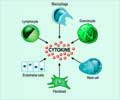Age-related macular degeneration is the leading cause of visual impairment in older adults, based on preliminary research conducted by National Institutes of Health (NIH) investigators.

"Our findings are epigenetic in nature, meaning that the underlying DNA is normal but gene expression has been modified, likely by environmental factors, in an adverse way," said Dr. Robert Nussenblatt, chief of the National Eye Institute (NEI) Laboratory of Immunology. Environmental factors associated with AMD include smoking, diet, and aging. "This is the first epigenetic study revealing the molecular mechanisms for any eye disease."
The study identified decreased levels of DNA methylation, a chemical reaction that switches off genes, on the interleukin-17 receptor C gene (IL17RC). The lack of DNA methylation led to increased gene activity and, in turn, increased levels of IL17RC proteins in patients with AMD. IL17RC is a protein that promotes immune responses to infections, such as fungal attacks.
The study, conducted by research teams from the NEI and other NIH institutes, including the National Heart, Lung, and Blood Institute and the National Center for Complementary and Alternative Medicine; the University of Melbourne, Australia; and Oregon Health and Science University, appears in the Nov. 29 issue of Cell Reports.
"Our study also suggests IL17- and IL17RC-mediated immune responses can be crucial in causing AMD," added Dr. Lai Wei, also of NEI's Laboratory of Immunology and first author on the paper. "By measuring IL17RC gene activity in at-risk patients, we have also potentially identified an early method to detect AMD."
AMD damages the light-sensitive cells of the macula, the central part of the retina that allows us to see fine visual detail. As the disease progresses, patients encounter great difficulty reading, driving, or performing hobbies and tasks that require hand-eye coordination. Treatments exist to prevent severe vision loss in certain types of advanced AMD but none prevent or cure the disease. Currently, 2 million Americans have advanced AMD and another 7 million have intermediate stages.
Advertisement
To test whether changes in DNA methylation might play a role in AMD, the investigators evaluated three pairs of twins—one pair identical and two pairs fraternal—where only one of the siblings had AMD. Identical twins have the same genetic makeup while fraternal twins share about half of their DNA. Because of their similar genetic backgrounds, identical and fraternal twins can be helpful in studying the differences between the effects of genetics and the environment. When compared with the unaffected twins, methylation patterns were altered in 231 genes of affected twins. This finding is consistent with the hypothesis that environmental exposures may epigenetically regulate expression of many genes and lead to AMD.
Advertisement
Based on these results, the authors propose that chronic increased levels of the IL17RC protein in the retina likely promote inflammation and recruitment of immune cells that damage the retina and lead to AMD.
"This study strongly implicates epigenetic DNA methylation as another crucial biological pathway for understanding the molecular basis of AMD," according to Nussenblatt.
The investigators next plan to evaluate what environmental factors may be responsible for the regulation of IL17RC and how the epigenetic regulation leading to the chronic inflammation in AMD patients can be reversed by novel therapies. They will also evaluate the role of epigenetics in other eye diseases.
Source-Eurekalert











